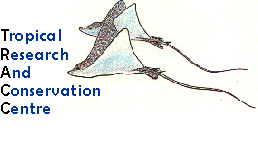|
|
|
|
Effects of blast fishing on coral reef structure
|
 |
|
|
|
TELL-TALE SIGNS OF BLAST FISHING
|
Lightly bombed reefs are pockmarked with blast craters but most reefs in northern Sabah have a continuous band of coral rubble instead of a reef crest and upper reef slope. The lower reef slope is a mix of rubble, sand and overturned coral heads. Typically, at the base of the reef slope is a mound of coral boulders, which have been dislodged by a blast and then rolled down the slope in an underwater avalanche. The reef slopes are mostly dead coral, loose sand, rubble or rock but occasionally have overturned clams or coral heads with small patches of living tissue protruding from the rubble.
Occasionally, the remains of very large Porites bommies are found as fist sized lumps of rock which have fractured in an angular way.
|
Blast fishing is particularly destructive because of the direct effect on fish and invertebrates within the blast zone. Not only are the preferred species and sizes killed but the blast also kills all the fish in that area. After one blast fishing explosion, over 2500 dead fish were counted in an area of less than 100 m2. These were mostly damsel fish and small fusiliers but also included juveniles and adults of all reef species. |
|
HARK NOW, WHAT'S THAT SOUND? The sound you heard was one blast at 11 nm (23 km or 18 miles). |
| Compare a blast
in a bay (note the echo) |
and a blast
further than 23 nm distance. |
|
|
|
|
PLEASE NOTE THAT THESE SOUNDS FILES ARE LARGE AND WILL TAKE SOME TIME TO DOWNLOAD, UNLESS YOU HAVE A FAST CONNECTION. |
|
|BLAST FISHING| |BLAST FISHING FREQUENCY| |ECONOMICS| |BLAST FISHING REGULATIONS| |EFFECTS ON BIODIVERSITY|
|EFFECTS ON CORAL REEFS| |ECOTOURISM PROTECTION|

![]()